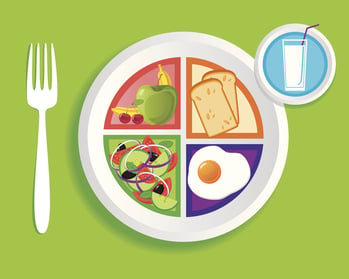 Some people think that snacking can sabotage your healthy eating plan. However, snacking keeps your energy levels up and prevents you from becoming overly hungry, which can lead to poor food choices. Eating every three to four hours can also help regulate your metabolism, which ensures that you burn calories throughout the day. Strive for at least two small snacks per day, but try to limit yourself to 100 to 150 calories or less per snack.
Some people think that snacking can sabotage your healthy eating plan. However, snacking keeps your energy levels up and prevents you from becoming overly hungry, which can lead to poor food choices. Eating every three to four hours can also help regulate your metabolism, which ensures that you burn calories throughout the day. Strive for at least two small snacks per day, but try to limit yourself to 100 to 150 calories or less per snack.
Also, be sure your snack is balanced—that it offers complex carbohydrates for energy, protein for muscle building and repair, and a small amount of fat for satiety. You can ensure nutritional balance and prevent snack boredom by varying your daily choices.
Best Snacks for Great Nutrition
Here are some great snack choices:
- 6 oz Greek yogurt topped with ½ cup of berries
- ¾ cup of whole-grain cereal, nut, and dried fruit trail mix
- 1 apple and 1 oz. low-fat cheese
- 1 cup yogurt smoothie made with real fruit
- 1 oz. baked tortilla chips with ¼ cup bean dip
- 2 oz. low-fat cheese on five whole-grain crackers
- 1 whole-wheat tortilla with 1 oz. melted cheese and ¼ cup salsa
- 1 cup raw vegetables and 2 Tbsp. low-fat dip or hummus
- 1 Tbsp. nut butter on a banana
- 1 cup berries topped with ¼ cup low-fat granola cereal
- ¼ cup whole-grain cereal and ¼ cup raisins with ¼ cup skim milk
- ¾ cup pasta salad made with raw veggies, cheese, and low-fat dressing
- ½ pita pocket stuffed with raw vegetables and 1 slice low-fat cheese
- 1 cup low-fat vegetable-bean soup
- ½ turkey and cheese sandwich on whole-wheat bread
- 1 handful almonds and ¼ cup dried cranberries
- ½ cup cottage cheese and ½ cup pineapple
- ½ peanut butter/banana sandwich on whole-wheat bread
- ½ whole-wheat English muffin toasted and topped with a slice of tomato and low-fat cheese
The Benefits of Snacks
You might feel guilty about snacking, but snacks aren’t necessarily bad. In fact, mini meals several times a day can be beneficial. Here’s how:
- Binge control. If eating several low-fat, whole-grain crackers, a few pretzels, a piece of fruit, or some raw vegetables keeps you from taking second or third helpings at your next meal, you may actually consume fewer total calories for the day.
- Extra energy and nutrients. Traditional, made-at-home meals often lose out to busy schedules. A grab-and-go snack can be the difference between some nourishment and none at all.
- Satisfaction for small appetites. Young children’s tiny stomachs can hold only small portionsof food at a time. Older adults who are less active and who burn fewer calories also may feel comfortable eating smaller meals more frequently.


 One of
One of  Grocery shopping takes time, preparation, patience, and organization. But throw kids in the buggy (or cart) with you, and usually you end up with a big old, stressful mess. Take it from a mom with three kids under the age of 5; I know firsthand that it can be done happily and without tantrums (well, for the most part). But it’s taken some practice.
Grocery shopping takes time, preparation, patience, and organization. But throw kids in the buggy (or cart) with you, and usually you end up with a big old, stressful mess. Take it from a mom with three kids under the age of 5; I know firsthand that it can be done happily and without tantrums (well, for the most part). But it’s taken some practice. 
 The holidays are right around the corner, and the first thing that comes to mind is all that food! You don’t want to look like a Santa at the start of the New Year! Well, don’t feel guilty about consuming the goodies; just get smart! If you have an understanding of what it takes to properly fuel your body, specifically as you age, the healthy eating process doesn’t seem so daunting. Older adults have different needs, and there are some key nutrients that are really important to maintain.
The holidays are right around the corner, and the first thing that comes to mind is all that food! You don’t want to look like a Santa at the start of the New Year! Well, don’t feel guilty about consuming the goodies; just get smart! If you have an understanding of what it takes to properly fuel your body, specifically as you age, the healthy eating process doesn’t seem so daunting. Older adults have different needs, and there are some key nutrients that are really important to maintain. 
 We see it, we eat it. Usually that’s how it goes, right? Of course we eat too much, but is it really our faults? Well, unfortunately for Americans, the portion distortion mania has gotten out of hand—and so has obesity. Over time, we’ve gotten so used to the larger portions being served at restaurants, we’ve come to think this is normal. Then of course that thinking spills over into a food addiction at home, too. More food, more food, more food. The craziness needs to stop now! (Here are
We see it, we eat it. Usually that’s how it goes, right? Of course we eat too much, but is it really our faults? Well, unfortunately for Americans, the portion distortion mania has gotten out of hand—and so has obesity. Over time, we’ve gotten so used to the larger portions being served at restaurants, we’ve come to think this is normal. Then of course that thinking spills over into a food addiction at home, too. More food, more food, more food. The craziness needs to stop now! (Here are 
 One of the biggest reasons people give as to why they aren’t eating healthy is the cost of foods,
One of the biggest reasons people give as to why they aren’t eating healthy is the cost of foods,  The other day I went out to dinner at a restaurant to celebrate a friend’s recent work promotion. Being a health-conscious person, I ordered grilled chicken and a salad with a small glass of wine. As I handed my menu to the waiter, my friends commented about how I didn’t “need a salad” and that I should “eat what I want” because I exercise enough.
The other day I went out to dinner at a restaurant to celebrate a friend’s recent work promotion. Being a health-conscious person, I ordered grilled chicken and a salad with a small glass of wine. As I handed my menu to the waiter, my friends commented about how I didn’t “need a salad” and that I should “eat what I want” because I exercise enough.